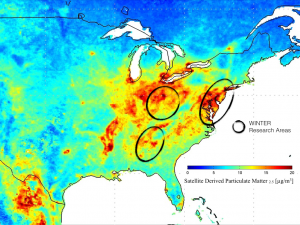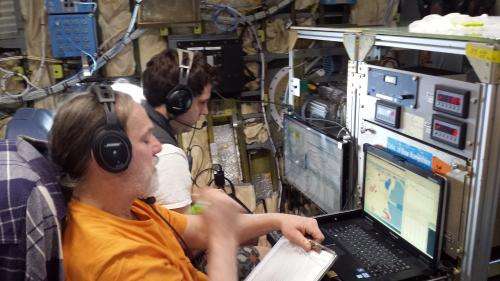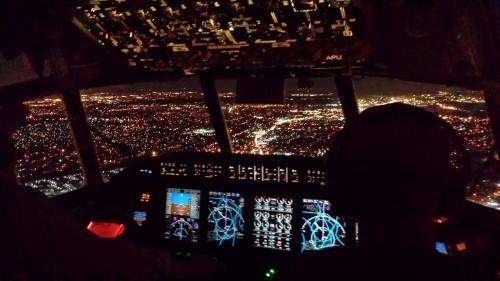Winter air campaign tracking how pollution handles the cold

When we think about pollution, we imagine the dark clouds puffing from smokestacks or tailpipes. But those clouds quickly rise upward, follow the winds, and react with other gases and particles in the air. These processes determine how much pollution actually reaches people and the environment. And, like everything else, they are affected by the seasons.
A University of Washington atmospheric scientist is leading a scientific effort to study the evolution of air particles in the eastern U.S. in the winter. The six-week Wintertime Investigation of Transport, Emissions and Reactivity (WINTER) campaign is sampling emissions through mid-March from their source to farther out in the environment, at all times of day and the long winter nights.
"We hope to better understand the fate of pollutants and their impact on the global atmosphere during wintertime," said lead investigator Joel Thornton, a UW professor of atmospheric sciences.
The project is measuring pollution from New York City south to Atlanta, over the coal-fired power plants of the Ohio River Valley, and in the more temperate southeastern U.S., and looking at what happens as those pollutants are blown offshore. Measurements are from a C-130 military transport plane owned by the National Science Foundation and operated for research by the National Center for Atmospheric Research.
The team is based out of a hangar at the NASA Langley Research Center in Hampton, Virginia, through March 15.
Observations include the amount and spatial pattern of the winter emissions, the timescale for them to be converted to other molecules such as ozone, or smog, as well as small particulates – the form of pollution most hazardous to health – and how those evolve over time.
The findings will be relevant for other densely populated places.

"This is directly applicable to emissions and transport of pollutants in any region that experiences shorter days, longer nights and colder temperatures during the winter," Thornton said.
Running the flights during winter presents some challenges.
"In winter, pollution over land often stays close to the ground," Thornton said. To sample these layers the group is conducting "missed approach" maneuvers in which an airport gives permission for the aircraft to come close to landing, about 100 feet from the ground, and then swoop back up while collecting measurements.
Low winter clouds are also an issue.
"If clouds extend too close to the water's surface they prevent the pilots from flying visually," Thornton said, "and we don't have a way to know whether the clouds are too low until we fly out to look."
The instruments on the plane include a machine developed by Thornton's group that takes precise chemical measurements several times a second. UW graduate student Felipe Lopez-Hilfiker and postdoctoral fellow Ben Lee are operating the instrument during the flights. UW graduate student Viral Shah and UW meteorologist Mike Warner analyze atmospheric forecasts to determine the best conditions to fly.

Co-principal investigator Lyatt Jaeglé, a UW professor of atmospheric sciences, helped with the flight plans in the first two weeks of February and participated in two of the surveys so far. The winter storms hitting the Northeast have postponed some of the research flights, she said, but the team has planned for some inevitable weather delays.
"The short daylight hours, cold temperatures and ground snow cover lead to different types of chemical reactions in the winter atmosphere compared with summer. In particular, nighttime chemistry plays a much more important role," Jaeglé said.
"We don't have that much information about what is going on in the winter," she added. "This will bring a wealth of information in terms of the transformation of pollutants."
The findings can be used to help regulate emissions and predict air quality during the winter months.
These measurements will complement a recent summer campaign, in which UW and other scientists sampled the air over the same region in June and July of 2013.
Provided by University of Washington
















